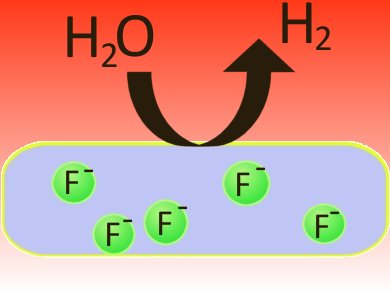Alberto Gasparotto and colleagues, Padova University, Italy, have made p-type Co3O4 nanostructured films for the photocatalytic production of H2. The team applied fluoride anion doping to the semiconducting Co3O4 films. Anion doping is common in n-type semiconductors, but rare in p-type and has never been reported for photoassisted H2 production.
The films were tested in water/ethanol solutions under both near-UV and solar irradiation. F-doped Co3O4 showed a five-fold H2 yield increase with respect to the corresponding undoped oxide upon near-UV irradiation. The H2 yields per gram of catalyst are among the best reported so far for semiconductor-based photocatalytic processes. The high activity was predominately attributed to replacement of surface −OH groups by F, leading to more free OH• radicals in the liquid-phase. This results in faster ethanol oxidation and concomitant enhancement of the H+ to H2 reduction.
Under simulated solar light, doped Co3O4 showed no decrease in H2 evolution after 20 h of irradiation. This time stability makes this material a very attractive photocatalyst.
- F-Doped Co3O4 Photocatalysts for Sustainable H2 Generation from Water/Ethanol
A. Gasparotto, D. Barreca, D. Bekermann, A. Devi, R. A. Fischer, P. Fornasiero, V. Gombac, O. I. Lebedev, C. Maccato, T. Montini, G. Van Tendeloo, E. Tondello,
J. Am. Chem. Soc. 2011.
DOI: 10.1021/ja210078d




